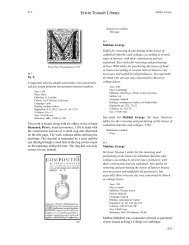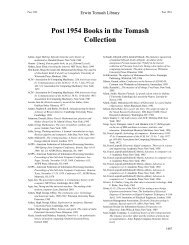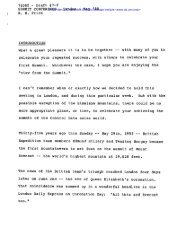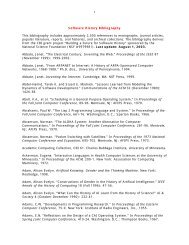B chapter.indd - Charles Babbage Institute - University of Minnesota
B chapter.indd - Charles Babbage Institute - University of Minnesota
B chapter.indd - Charles Babbage Institute - University of Minnesota
You also want an ePaper? Increase the reach of your titles
YUMPU automatically turns print PDFs into web optimized ePapers that Google loves.
132<br />
into perches grotes turned into dayeworkes. xl.d<br />
into a roode, a noble into di. acre, a Royal into .iii.<br />
roodes: a marke into an acre, & poundes turned<br />
into Markes, the which there be name acres.<br />
A short section at the end discusses how To measure<br />
Tymber or Stone, in length, breadth and depthe by the<br />
foote square.<br />
Like many other books <strong>of</strong> this era, for example, the<br />
illustration <strong>of</strong> Ptolemy in Gregor Reisch’s Margarita<br />
philosophica (<strong>of</strong> which the woodcut in this volume is<br />
only a crude copy), this work continues the suggestion<br />
that Ptolemy was the inventor <strong>of</strong> the quadrant (see<br />
illustration <strong>of</strong> the goddess <strong>of</strong> astronomy showing Ptolemy<br />
how to use a crude quadrant). It also continues the error<br />
that Ptolemy was a king <strong>of</strong> Egypt (note the crown and<br />
royal robes). The old typeface and random spelling make<br />
this a quite interesting book.<br />
Illustrations available:<br />
Title page<br />
Ptolemy<br />
Table<br />
Erwin Tomash Library<br />
Bennett, Wendell Clark Berkeley, Edmund Callis<br />
B 136<br />
Bennett, Wendell Clark (1905–1953)<br />
Ptolemy, B 135<br />
Numbers, measures, weights and calendars.<br />
Year: 1949<br />
Place: Washington, D.C.<br />
Publisher: Smithsonian Institution U.S.G.P.O.<br />
Edition: Extract<br />
Language: English<br />
Binding: original printed paper wrappers<br />
Pagination: pp. [2], 601–610<br />
Size: 242x154 mm<br />
weights and measures, and calendar systems <strong>of</strong> major<br />
native groups in South America.<br />
Illustrations available:<br />
Title page<br />
B 137<br />
Berkeley, Edmund Callis (1909–1988)<br />
Circuit algebra - introduction.<br />
Year: 1952<br />
Place: New York<br />
Publisher: Edmund C. Berkeley Associates<br />
Edition: 1st<br />
Language: English<br />
Figures: 24 figures in text<br />
Binding: original paper wrappers<br />
Pagination: pp. [1], i, 34<br />
Size: 280x216 mm<br />
Berkeley, a native <strong>of</strong> New York, graduated with an A.B.<br />
summa cum laude in mathematics from Harvard in 1930,<br />
entered the computer field in 1938 as an actuary using<br />
punched card machines for the Prudential Insurance<br />
Company <strong>of</strong> America, and worked with Howard Aiken<br />
during the war as an active-duty naval reserve <strong>of</strong>ficer.<br />
After the war, he returned briefly to Prudential, where<br />
he participated in studies that led to the purchase <strong>of</strong> a<br />
UNIVAC I. In 1947, a meeting to which he invited seven<br />
friends resulted in the establishment <strong>of</strong> the Association<br />
for Computing Machinery, better known as the ACM.<br />
Berkeley was the first member and acted as secretary<br />
until 1953. He went into business for himself as Edmund<br />
C. Berkeley and Associates in 1948 (later Berkeley<br />
Enterprises), started a publication known as Computers<br />
and Automation in 1951, consulted for industry, and<br />
This small extract was originally published in the<br />
Smithsonian Institution, Bureau <strong>of</strong> American Ethnology,<br />
Bulletin 143, Handbook <strong>of</strong> South American Indians Vol.<br />
5, pp. 601–610. It briefly describes number systems, B 137







